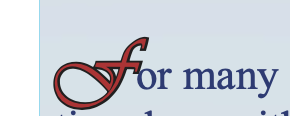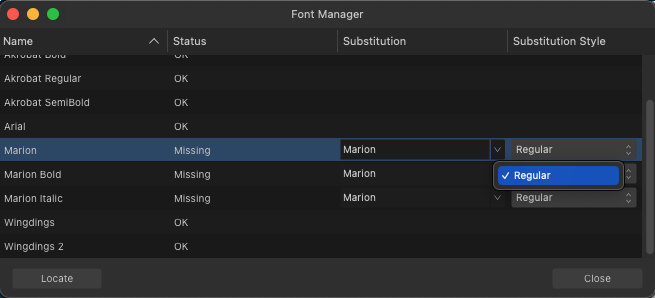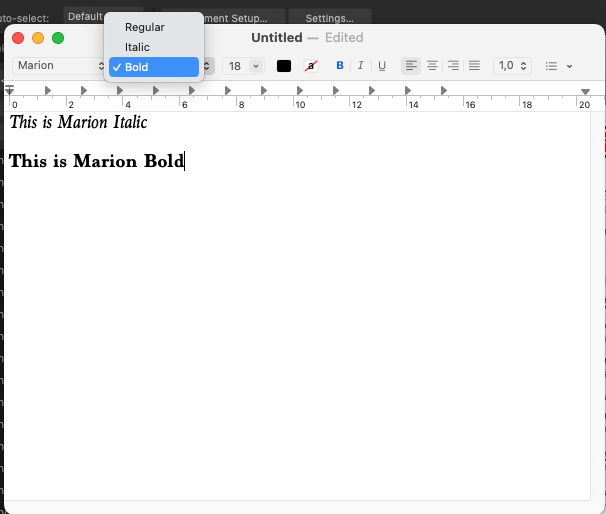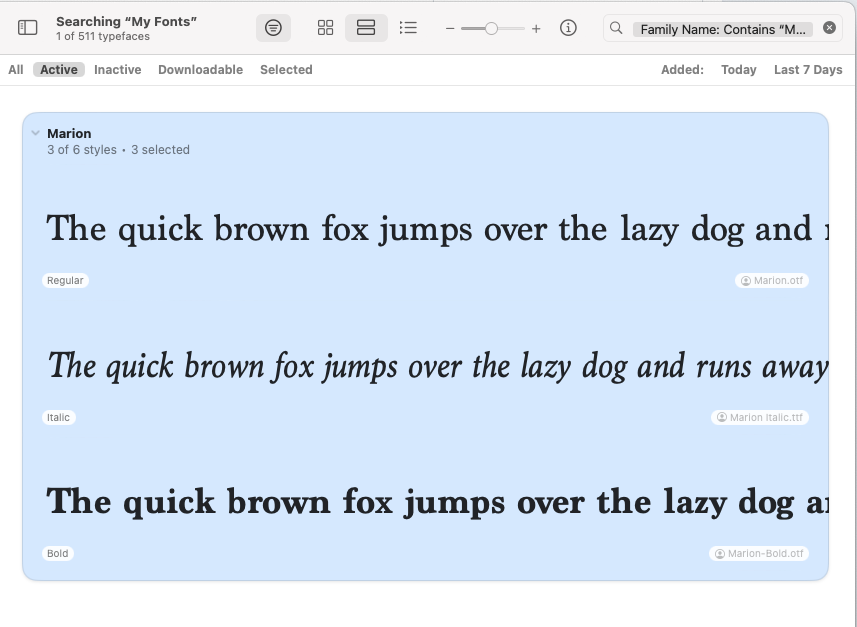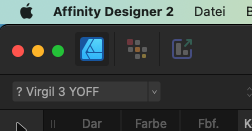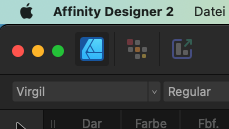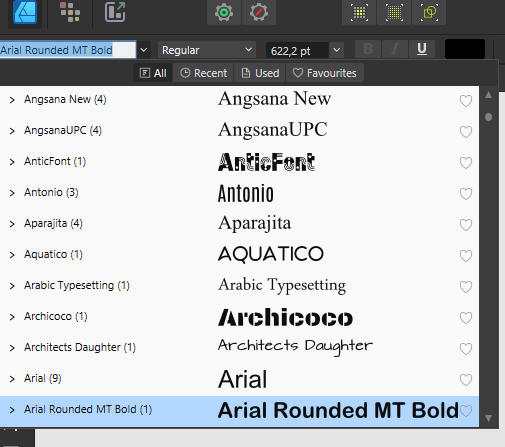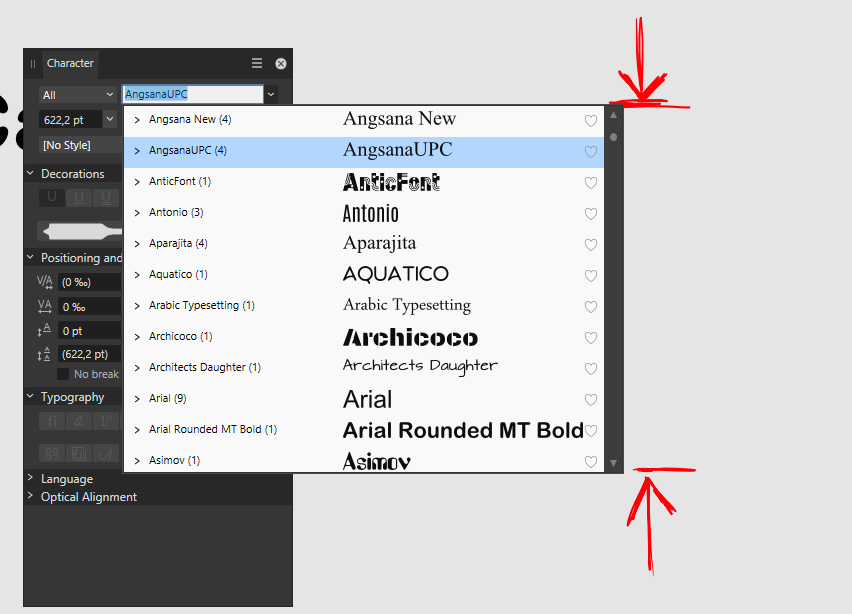Search the Community
Showing results for tags 'Fonts'.
-
Hi, I'm currently working on a book. I've rented a font (Pensum) from Fontstand and using it with Affinity Publisher v2 (Mac). Everything works fine with titles and body paragraph styles, but when I tried to use it with the Table of Content styles it doesn't recognize the font. The name is there but the result is weird and misplaced characters from another font. If I change to an installed font (say Palatino) everything is fine again. Just wanted to know if ti was a bug or I was doing something wrong. Thank you, Raul.
- 20 replies
-
- fontastand
- fonts
-
(and 1 more)
Tagged with:
-
I'm typing in TW Cen MT in Affinity Publisher 2 on Windows, and I'd like to type the character a with a macron (ā), but the font doesn't include that character. However, it does include the macron as a separate character (¯). Is there any way I can combine a with ¯ by messing with the font settings? Alternatively, is there any way to add new glyphs to a font?
-
🇬🇧 Hi, I often use the font provided with the macOS system, “Emoji Color”. The illustrations are beautiful, they can help in an intermediate phase of creation or in a publication and cover several different themes… The “Glyphs” Palette available in the three software packages of the Affinity suite allows you to view these illustrations. Unfortunately, the “image-characters” of this font are enriched as operating system evolves. If we consider a specific theme, all of its images are distributed anywhere within the font, they are not grouped together, which imposes a loss of time and patience to visually find the right image… 😡 I offer here Content bringing together “almost” all of the illustrations of this “Emoji Color” font, which is located in the (protected) system folder –> Library –> Fonts, from my mac which is currently running macOS Ventura 13.6.4. The font is in version 18.3d3e1. The illustrations included in this font are bitmap images, cut out, without background, a sort of .png!… After analyzes and tests, the maximum definition seems to be 160 x 160 px. No wonder file is almost 190 MB: these are not simple vectors that make up this font, but RGB images with alpha channel and there are hundreds of them!… In AD, we define a text box in AD, we choose the “Emoji Color” font and we select (all?) the illustrations belonging to a specific theme. Then, we apply the “Convert to Curves” function to recover all the bitmaps which are then incorporated into Content, all classified by theme. Here are the main themes that I was able to identify: > Sports > Hands > Squares Rounded Corners > International Flags > Faces and Human Activities > Bodies and Human Activities > Animals > Smileys > Food > Weather & Cosmos > Hearts > Objects > Art & Culture > Transport & City Unfortunately, there are still a few orphans!… 🇫🇷 Bonjour, j'utilise souvent la police de caractères fournie avec le système macOS, “Emoji Color”. Les illustrations sont belles, elles peuvent aider pour une phase intermédiaire de création ou dans une publication et s'étendent sur plusieurs thèmes différents… La Palette “Glyphes” disponible dans les trois logiciels de la suite Affinity permet de visualiser ces illustrations. Malheureusement, les “caractères-images” de cette police de caractère est enrichi au fur et à mesure de l'évolution du système d'exploitation. Si l'on considère un thème précis, l'ensemble de ses images est réparti n'importe où au sein de la police, elles ne sont pas regroupées ensemble, ce qui impose une perte de temps et de patience pour visuellement trouver la bonne image… 😡 Je propose ici un Contenu regroupant “presque” la totalité des illustrations de cette police de caractère “Emoji Color”, qui se trouve dans le dossier système (protégé)–> Bibliothèque –> Fonts, depuis mon mac qui est actuellement sous macOS Ventura 13.6.4. La fonte est en version 18.3d3e1. Les illustrations inclues dans cette fonte sont des images bitmap, détourées, sans fond, des sortes de .png !… Après analyses et tests, la définition maximale semble être de 160 x 160 px. Rien d'étonnant que le fichier fasse presque 190 Mo : ce ne sont pas de simples vecteurs qui constituent cette fonte, mais des images RVB avec couche alpha et il y en a des centaines !… Dans AD, on défini une zone de texte dans AD, on choisi la fonte “Emoji Color” et on sélectionne (toutes ?) les illustrations appartenant à un thème précis. Ensuite, on applique la fonction “Convertir en forme” pour récupérer tous les bitmaps qui sont ensuite incorporés dans un Contenu, le tout classé par thème. Voici les thèmes principaux que j'ai pu identifier : > Sports > Hands > Squares Rounded Corners > International Flags > Faces and Human Activities > Bodies and Human Activities > Animals > Smileys > Food > Weather & Cosmos > Hearts > Objects > Art & Culture > Transport & City Malheureusement, il reste encore quelques orphelins !… Emoji Color.afassets.zip
-
About a year ago, I used the FUTURA font in my title and when I clicked on "fix" PDF, AFP2 added a carriage return for each word. Yesterday I encountered a new issue, all the dynamics are wrong. The final note should have a dynamic marking of mp. After clicking on "fix", they all went wonky instead. iMac >>> Music created in Sibelius. Exported to PDF. Imported into AFP2. Asked to click on "fix" >>> Resulting font problem.
-
Good day, I need your help in identifying this font. Here's a bit of history with this font. I bought this font package over 15+ years ago when I was using Adobe Indesign and running a windows machine. Over the next decade, I switched over to Mac computers and approx. 2018 started using Affinity publisher... I lost track of the whereabouts of this font package and would like to buy a copy to use with A. Publisher. Here are a few examples of some of the unique letter designs of this font package that I screen captured from an old document of mine. Any ideas would be greatly appreciated and thanks for your help. All the best Greg
- 14 replies
-
- affinity publisher
- fonts
-
(and 1 more)
Tagged with:
-
Variable fonts support
Anibal Murillo replied to Athanasius Pernath's topic in Feedback for the Affinity V2 Suite of Products
Affinity is a great program; you have done a fantastic job. I believe it is largely because they have listened to users. Please add the ability to handle variable fonts; it is an immediate necessity! -
If this topic is in the forums for v2, I couldn't find it. When I open a Designer file that is missing fonts, I get the popup window telling me what those fonts are. But before I can get to my actual font manager to load the fonts, it disappears. I can't find anywhere in Designer 2 to open the font manager. What am I missing?
- 6 replies
-
- designer 2
- fonts
-
(and 1 more)
Tagged with:
-
the font I have problem with is: Seravek It was the default font on my mac. Once upon a time I've updated macos and found that they delete the font from the system, so I reinstalled it to my mac manually but anyway affinity designer doesn't see the font (other apps see) I need that font, how to make it work?
- 8 replies
-
- affinity designer
- font
-
(and 2 more)
Tagged with:
-
I recently opened up a Publisher file to create a new version and noticed one of the fonts (Marion) was broken. I eventually got the regular version to work (I moved my fonts to my User folder instead of the main Library folder) however, it still does not recognize the italic or bold versions of this font. I tried deleting and downloading the files again, but nothing changed. I thought it was a Publisher problem, but Designer does not recognize the alternate versions either. I thought it might be a TTF vs OTF problem, so I downloaded OTF versions, but neither Affinity app sees anything but Marion Regular. I tested in TextEdit, and it sees all variations of the font. This makes me think it's an Affinity problem, not a font file problem. I'm running Publisher 2.2.0 on Mac OS 13.6. I need these alternates to work. Help!
-
Text written in a Sanskrit font appears with a thin body weight instead of a regular weight. It exports at the proper weight in a PDF, but it looks wrong in the program itself. I have a body text that uses Roman letters, Japanese, Chinese, and Sanskrit in the same paragraph. I use the Noto Sans and Serif font families, including Noto Sans CJK JP, and Noto Sans Devanagari (as there is no Serif versions of these foreign language fonts). In the font selection field, all of the 9 style options for Devanagari are listed as "regular," even though they appear as light. This is not a problem in InDesign, where all 9 display properly, from Thin, to Regular, to Black. This is not an issue in InDesign or Word. I tried importing the text via IDML and via Word. In both cases, Publisher displays the Sanskrit text as a lighter version of its regular self. It then exports it as a regular weight. This difference in weight throws off the readability in Publisher, and may also effect the distribution of characters and line width.
- 3 replies
-
- affinity publisher
- fonts
-
(and 1 more)
Tagged with:
-
Hello, I have just bought AP2 and Word Mac (2021). When I try to import text, say, in Calibri into AP I get a "? Calibri". Calibri and other Word fonts are not visible in the list of fonts in AP but are visible in Word. And Word will print them (ie, not substituting). Yet Calibri is not visible in Font Book either. How to I get the Word fonts into AP2? Help for this newbie would be appreciated.
- 15 replies
-
Sometimes, if I open a document in AD (2.1.0 Mac M2, Ventura 13.4.1) I get a weird warning that a font I used is missing. But the font is there! Current case: I just created a document with my default font Virgil, which I always use for my comics. I made the export and closed it in AD. I found a mistake in the exported PNG, reopened it and then I got the error message. Affinity seems to change the font name within the document. In this case from "Virgil" to "Virgil 3 YOFF" I assume that this is the physical file name of the font. I installed no software, no updates, didn't even restart the system. Just closed and reopened the file. The bigger question is: Why isn't there a tool to replace a font in Affinity (like in Adobe products)? Even in Publisher you just have this "substitution". But no option for a permanent replacement... best regards Dave
- 4 replies
-
- affinity designer
- fonts
-
(and 1 more)
Tagged with:
-
I am really hesitant to change the spacing of my letters because it alters every usage of that font after that. This can't be the way this is supposed to behave. I only wish to alter a single instance of lettering to allow it to fit in the margins of a document. This happens when I am using the artistic text tool or a text frame. No matter what the font is it doesn't revert back to the default positioning of the characters. This seems very odd to me.
-
Hello! I have been having issues with the fonts installed from Adobe, this problem stated happening with the last update of Publisher on iPad, and it is only there, Photo and Designer works perfectly fine. If someone could help me I would be very thankful, I have some homework to do and nothing works for a solution. :’(
-
I am not sure if there is a clear explanation for this behavior by the suite but why is it that in this Designer displays one character incorrectly when it come to most Farsi/Arabic fonts?
-
I recently upgraded to V2, which came with the Publication Typefaces Collection (https://affinity.serif.com/en-gb/store/upgrade-offer/). While I can see the other assets in the Creative Collection through the Assets panel (Window > Assets), I can't make out where the fonts from the Typefaces Collection are located and how I go about installing them. Thanks!
-
I sometimes write in multiple languages, and when I use a font that doesn't support the language, Designer automatically chooses a similar font that supports the language I'm writing in. Is there a way to know what font Designer has chosen for me?
- 8 replies
-
- affinity designer
- fonts
-
(and 2 more)
Tagged with:
-
Hello all, I'm making identical width images whose text sizes I want to match up as they are part of a multi-image collage (text scrolls for a Kickstarter campaign body). Weirdly, in one file font size 5 looks like this: and in another, I had to increase font size to 12 and it still looks smaller than 5 above: In both cases it's the same font, in a text frame, in a file of identical width. Why in the second file does my text look so much smaller....and how can I fix it so font size 5 looks the same across all my files?
-
Using the entire V.2 suite, Windows 11 OS. Created slides natively and exporting to PDF; using Open Sans fonts. They look fine, on the program. The fonts on the exported PDFs, however, are noticeably thicker; also with occasional errors (like lowercase "f" strangely becoming an "8"). I've reloaded my fonts two times on Windows; the "thick" output happens no matter what I've done (even using Open Sans Light, it mysteriously "thickens" the font).
- 4 replies
-
- open sans
- pdf export
-
(and 1 more)
Tagged with:
-
I have to modify a PDF where I can reorganize sections of a music PDF. The music comes through just fine, as well as most of the text. However the vocal lines have the weirdest letter spacing I have seen. Publisher imports text with tabs in the middle of the lyrics. The lyrics are in Times New Roman, so its not a case of me not having the right font on my computer. InDesign and Acrobat Pro can open it just fine, as well as several other files. I certainly am puzzled by this behaviour. I'm pulling the plug on Adobe the middle of January, and would really like to sort this out. I don't modify music very often at all, but this gives me pause with Affinity's relationship with PDFs. Excerpt- Acrobat-On Eagle's Wings - Eb Major.pdf
-
Hi there, I'm looking to use an Adobe CC font(s) in my Affinity v2 apps for iPad, and having browsed a few older forum threads, I am still unsure whether or not this is currently possible. In the Affinity apps, the fonts from Adobe CC are showing up in the text panel's font menu, but cannot be applied to text in the document (the font name appears in red with a question mark, as though it is missing). To clarify, Adobe CC fonts work as expected in the Affinity desktop apps. Hopefully it's the case that I'm missing something obvious, and not that Adobe CC fonts are incompatible at the moment. Any advice would be appreciated, and regardless, I truly love and appreciate each one of these apps. Thank you.
-
I've had issues exporting previous iterations of this project on MacOS v1, and on v2. I recently cleaned up the document and packaged it to eliminate as much bloat as I could find, and it's still getting stuck. I'm guessing its something to do with the project—is it simply too big, or something else? If the former, what are some best practices for managing export times on large projects? I also wasn't able to get Publisher 2 to locate instances of fonts on iPad, the locate function on macOS v2 worked fine, as did locating images on iPad. Is this feature not implemented on iPad, or could something have been causing the locate function to fail? 1091990879_ExportFailedProjectPackage.zip
-
.thumb.jpg.cebca0cd223c277a07c986819a33011a.jpg)
Add a Built-In Font Creator
rawii22 posted a topic in Feedback for the Affinity V2 Suite of Products
I don't know if I'm just not familiar enough with the affinity suite and haven't found this feature, but there's a feature that I've been wanting for some time. I would like for there to be a tool in affinity designer that streamlines the creation of a new font and allows you to export to a font file format. I want to be able to easily do something like select a letter to work on, design it, and repeat for each letter. Maybe they can add an option to create a "New Font Project..." This would make the font creation process infinitely easier and much more accessible to someone like me who doesn't need to create fonts very often. Every time I want to create a font I'm met with a million steps, and a million potential websites, but never one easy software feature that integrates the design and the workflow into one place. Affinity seems like a prime contender for such a feature, and they already have an amazing base of existing features to work with. Let me know if anybody else feels something similar, or if you think I'm inept and have to get over it 😆. I just want to be able to keep falling back on affinity for my every design need! I just found this forum post and I'm hoping that the new release of V2 makes it possible for affinity to add this feature.- 19 replies
-
- font
- font creator
-
(and 5 more)
Tagged with:









